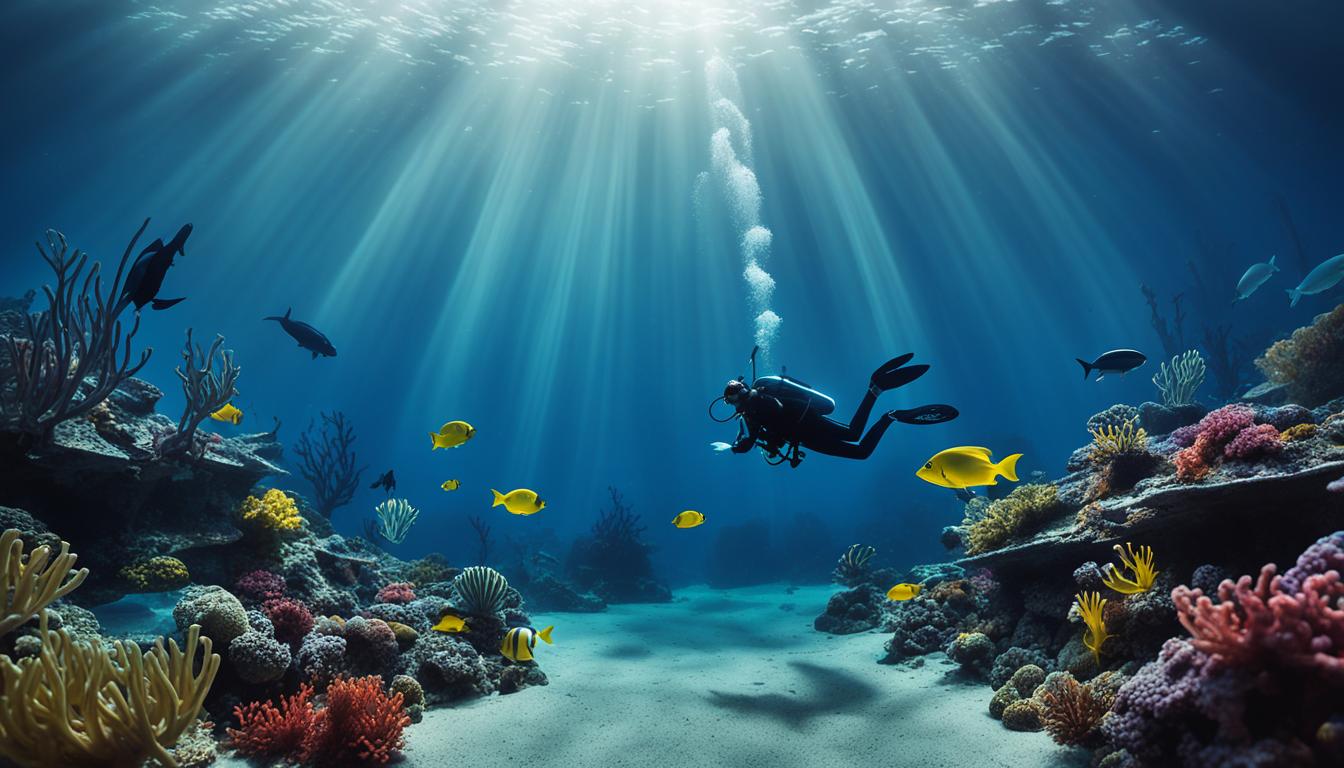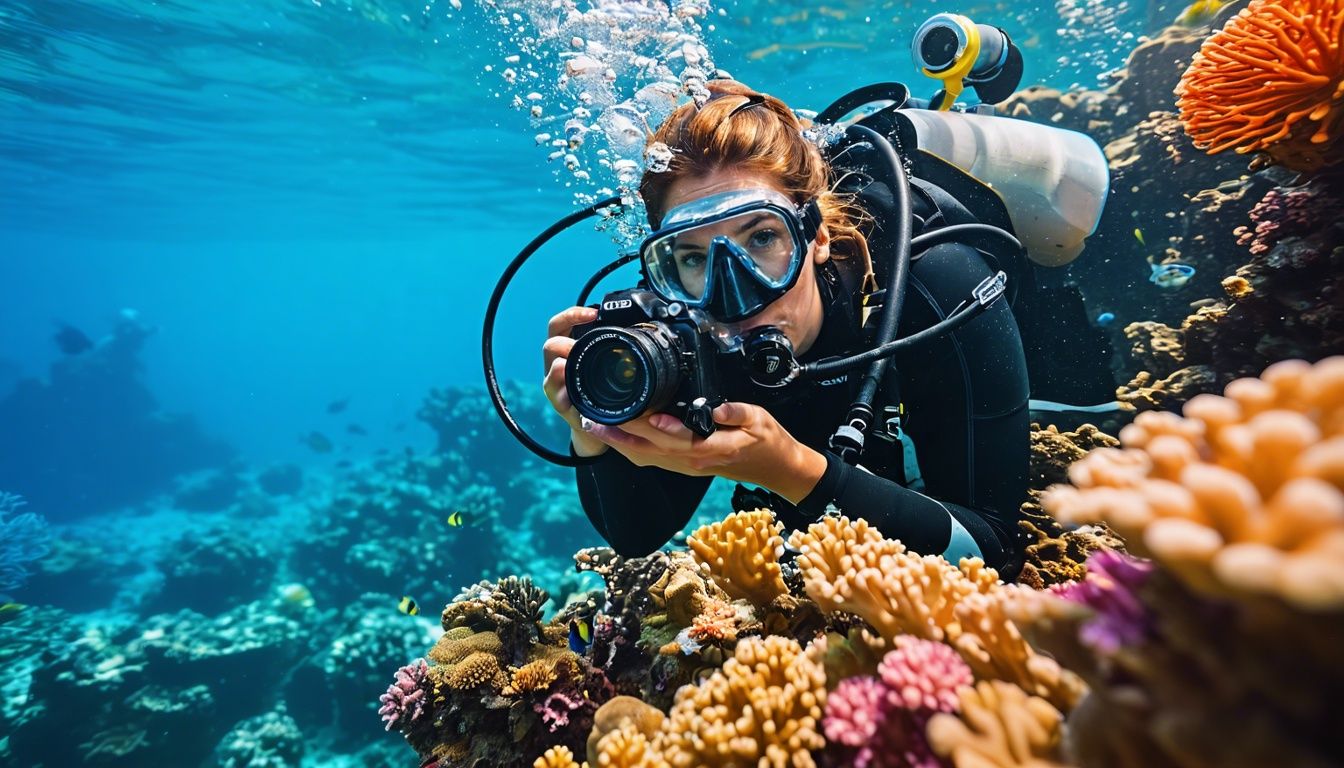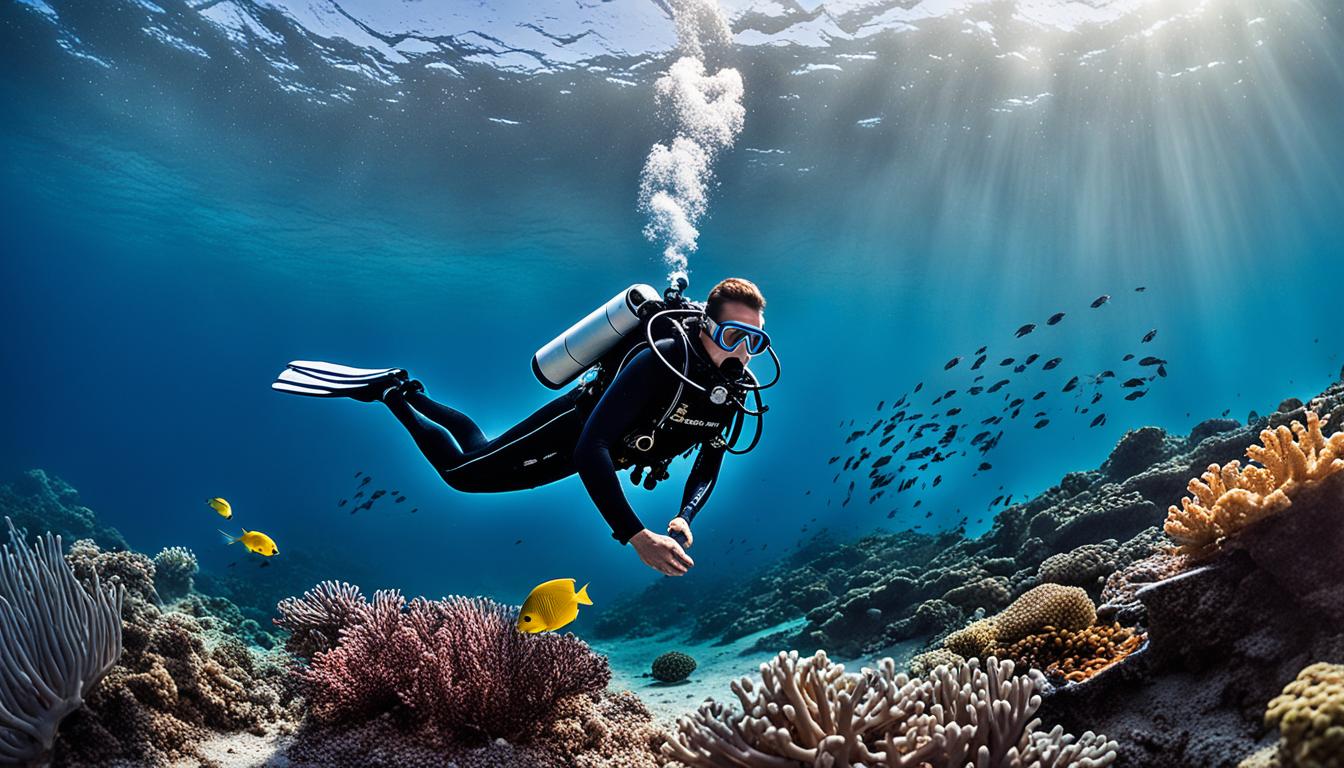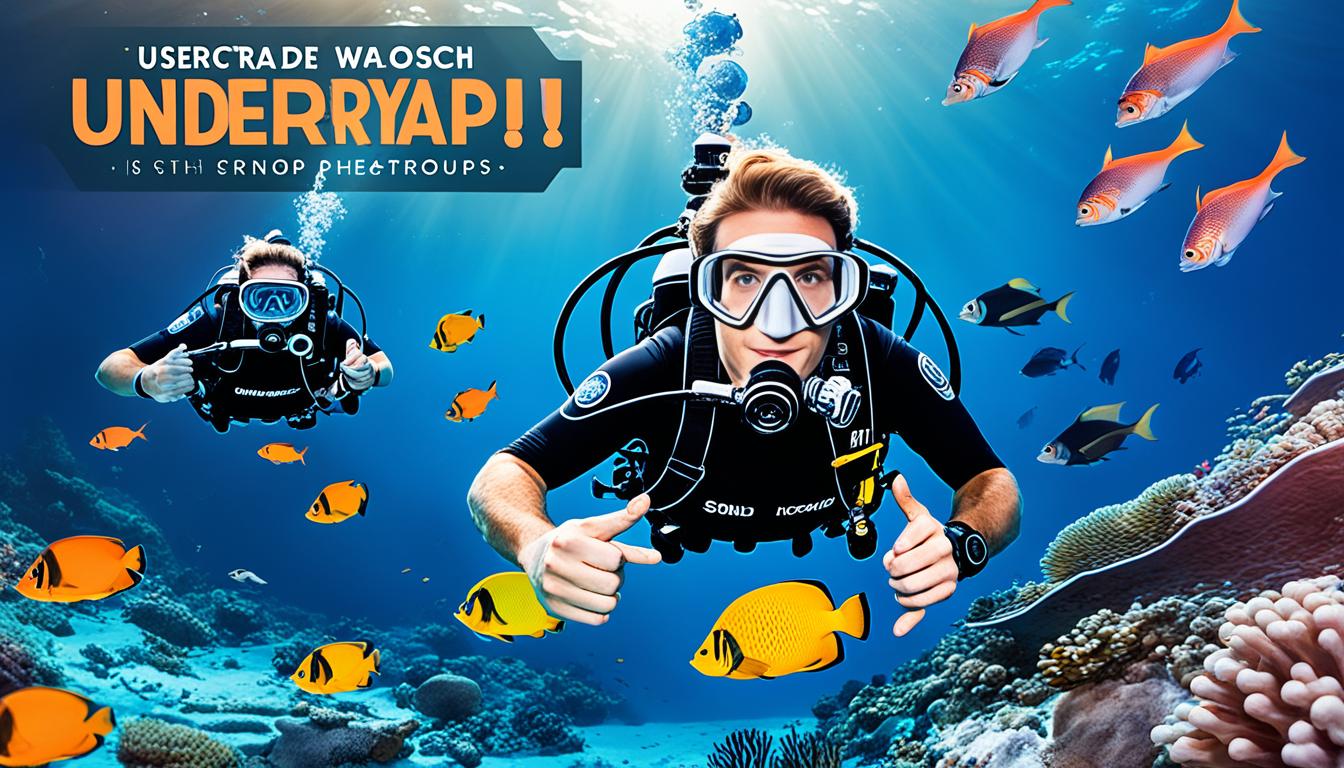Welcome to our guide on mastering the art of underwater photography, specifically focusing on the captivating aspects of reflections and silhouettes. In the vast ocean depths, capturing the beauty of underwater scenes requires creativity and technical skill. By understanding various creative techniques and leveraging the unique properties of natural and artificial light, you can create stunning images that evoke wonder and awe.
In the realm of underwater photography, reflections and silhouettes offer endless possibilities for visual storytelling. Reflections can add depth and dimension to your images, while silhouettes create dramatic contrasts against vibrant backgrounds. These techniques allow you to craft unique and compelling narratives that transport viewers into the enchanting world beneath the waves.
Throughout this guide, we will explore the intricacies of mastering underwater photography, with a specific focus on reflections and silhouettes. We will discuss the creative techniques that can bring your underwater images to life, from harnessing the power of natural light to maximizing the potential of artificial light. Additionally, we will delve into the art of blending ambient and strobe light to achieve artistic effects.
Let’s embark on a journey to unlock the secrets of underwater photography and discover how you can elevate your craft to new heights.
Key Takeaways:
- Underwater photography is a creative art that requires skill in handling light and utilizing it to capture stunning images.
- Mastering natural light is crucial in underwater photography, from using color filters to restoring lost colors in the depths to shooting in shallow water environments.
- Artificial light, provided by strobes, plays a vital role in underwater photography, with careful strobe positioning and power adjustment necessary to minimize backscatter.
- Creating beautiful silhouettes requires strong contrast and proper exposure techniques, such as using manual mode or spot metering.
- Capturing reflections involves finding still water surfaces and positioning yourself at the right angle to achieve the desired effect.
Harnessing the Power of Natural Light
Underwater photography relies on the beauty of natural light. However, as we descend into deeper waters, the availability and quality of natural light diminish. Reds, oranges, and eventually all colors start to disappear, leaving behind a blue-tinted environment. But fear not! We have some tricks up our sleeves to counteract the loss of color and bring life back into your underwater images.
One powerful tool at our disposal is the use of color filters. These filters can be mounted on the front or back of the lens, and they work like magic to add back the vibrant reds and oranges that are lost in the depths. By strategically using color filters, we can restore the natural colors and capture stunning underwater scenes that truly pop.
Shallow water environments, where sunlight can still penetrate effectively, offer the perfect opportunity to capture the beauty of natural light without the need for filters or strobes. Think about shallow reefs with their colorful inhabitants, surface-dwelling animals like whales and dolphins, or crystal-clear springs with mesmerizing clarity. In these scenarios, natural light alone can illuminate the subjects and create breathtaking images.
Let’s take a closer look at the power of natural light and how we can harness it to create stunning underwater photography. Here’s a table summarizing the key factors for utilizing natural light:
| Key Factors | Use of Natural Light |
|---|---|
| Depth | Shallow waters where sunlight can still penetrate effectively |
| Color Restoration | Color filters to add back reds and oranges |
| Subject Selection | Shallow reefs, surface-dwelling animals, clear springs |
By understanding the unique properties of natural light, utilizing color filters when necessary, and selecting suitable subjects, we can capture the beauty of the underwater world. So, let’s dive in and explore the magical possibilities of natural light in underwater photography!
Maximizing the Potential of Artificial Light
Artificial light plays a vital role in underwater photography, allowing us to illuminate our subjects and capture their true beauty. Strobes or flash units are commonly used to provide this artificial light source, enhancing the colors and details of our underwater images.
However, one challenge that often arises when using strobes is backscatter. This occurs when particles in the water reflect the strobe light back into the lens, resulting in unsightly white blobs in our photographs. Fortunately, there are techniques to minimize backscatter and maximize the potential of artificial light in our underwater photography.
To reduce backscatter, it’s important to position the strobes strategically. Placing them behind the dome port, which is the round portion in front of the lens, helps to minimize direct reflections. Additionally, adjusting the power of the strobes can prevent excessive light from bouncing off particles and causing backscatter.
Another helpful tool in combating backscatter is the use of dome diffusers. These attachments soften and scatter the light emitted from the strobes, reducing the likelihood of it reflecting off particles and creating backscatter in our images.
The position of the strobes in relation to the housing of our underwater camera setup is also crucial. A commonly used position is placing the strobes 8-12 inches away from the housing, facing forward at nine and three o’clock angles. This positioning helps to achieve even lighting and reduce the chances of backscatter.

Experimentation with strobe power and position is key to finding the optimal lighting setup that works for your specific underwater subjects and conditions. Each underwater photography scenario may require slight adjustments to achieve the desired results.
By maximizing the potential of artificial light and understanding how to minimize backscatter, we can capture stunning underwater photographs that showcase the vibrant colors and intricate details of our underwater world.
Creating Beautiful Silhouettes in Underwater Photography
Silhouette photography presents a unique and captivating way to capture underwater subjects. By positioning subjects with strong shapes or recognizable forms against a bright backdrop, such as the sun or bright water, we can create dramatic and impactful images.
The key to achieving stunning silhouettes is strong contrast between the subject and the background. By turning off strobes and using backlighting, we can enhance the crispness and intensity of the silhouette. This technique works best when the subject is isolated from the reef or placed in blue water, allowing for a clear distinction between the subject and its surroundings.
To achieve the desired effect, we recommend using manual exposure mode or spot metering on the brighter area of the background. This ensures that the subject remains in shadow while the background remains bright, creating a striking contrast.
“Silhouettes add a sense of mystery and intrigue to underwater photography. They allow us to focus on the shape and form of the subject without the distraction of color and detail.”-David Clark, Underwater Photography Expert
Another technique to enhance the impact of silhouettes is to use a high shutter speed to freeze the subject and avoid any motion blur. Bracketing exposures and slightly underexposing the blue water can further ensure a black silhouette.
For an extra touch of creativity, consider incorporating a sunburst effect into your silhouettes. This technique can add a dynamic element to the photo, drawing the viewer’s attention to the subject.
Tips for Creating Beautiful Silhouettes:
- Position subjects with strong shapes or recognizable forms against a bright backdrop.
- Turn off strobes and utilize backlighting to enhance the silhouette’s contrast.
- Use manual exposure mode or spot metering on the brighter area of the background.
- Isolate the subject from the reef or place it in blue water for clear distinction.
- Use a high shutter speed to freeze the subject and avoid motion blur.
- Bracket exposures and slightly underexpose the blue water for a black silhouette.
- Consider incorporating a sunburst effect for added visual appeal.
By applying these techniques, you can create stunning silhouettes that evoke emotion and capture the beauty of underwater photography.
Tips for Capturing Reflections in Underwater Photography
When it comes to capturing stunning reflections in underwater photography, there are a few key tips to keep in mind. The first and most important factor is the condition of the water surface. Reflection shots turn out best when the surface is calm and still, allowing for a clear mirror-like reflection.
One optimal time to shoot reflections is early morning, as the conditions are typically more favorable during this time. The water is often quieter, providing a perfect opportunity to capture crisp and captivating reflections.
The angle of your shot also plays a crucial role in capturing reflections effectively. To achieve a complete reflection, it’s important to consider the angle from the subject to the surface. Ideally, this angle should be less than 42 degrees to ensure maximum reflection and clarity. Experimenting with different angles can lead to unique and visually appealing results.
In addition, being close to the water’s surface and seeking out subjects with strong shapes or easily recognizable forms can enhance your reflection shots. This allows the reflection to be more prominent and adds visual interest to your composition. Snorkeling is a great way to explore subjects at the surface and find unique opportunities for reflection photography.
While capturing reflections, it’s crucial to control your breathing and minimize bubbles to avoid disturbing the water’s surface. This helps maintain the stillness and clarity needed for clear reflections. Taking slow, deliberate breaths and exhaling carefully can make a significant difference in the quality of your shots.
Remember, capturing reflections in underwater photography requires patience, attention to detail, and experimentation. By applying these tips and techniques, you can create stunning images that highlight the beauty and serenity of still water reflections.
Blending Ambient and Strobe Light for Artistic Effects
Blending ambient light and strobe light in underwater photography can create captivating and artistic effects while seamlessly integrating the two light sources. This technique is particularly beneficial in wide angle photography, especially in close focus wide-angle (CFWA) shots.
CFWA involves capturing a small subject in the foreground while including the surrounding environment in the background. The aim is to blend the subject, the surrounding area, and the background light to create a harmonious image that tells a compelling visual story.
To achieve even lighting throughout the image, proper strobe positioning and power adjustment are crucial. Placing the strobes strategically and using a dome port can help distribute the light evenly, minimizing shadows and creating a balanced composition.
By blending ambient light and strobe light effectively, you can enhance the details and colors of the subject while maintaining the natural beauty of the underwater environment. The seamless integration of the two light sources allows for a captivating visual experience that draws viewers into the underwater world.
Embrace your creativity and experiment with different lighting techniques to achieve stunning and visually engaging results in your underwater photography.
| Benefits of Blending Ambient and Strobe Light | Effective Techniques |
|---|---|
|
|
Overcoming Challenges and Mastering Light in Underwater Photography
Mastering light in underwater photography is a continuous learning process for us photographers. We understand that experimentation is the key to discovering new lighting techniques and pushing the boundaries of our creativity. By manipulating strobe power, adjusting strobe positions, and utilizing natural light and color filters, we can achieve the desired effect of natural and even lighting in our images.
Underwater environments present unique lighting challenges that we must overcome. With limited natural light and the issue of backscatter, it takes both skill and creativity to capture stunning underwater images. Throughout our careers, we dedicate ourselves to perfecting our understanding of light and using it creatively to bring out the beauty of the underwater world.
Experimentation: The Path to Innovation
In the world of underwater photography, we strive to push the boundaries and constantly explore new lighting techniques. Through experimentation, we discover innovative ways to manipulate light and create captivating images. Whether it’s adjusting the power of our strobes, trying different strobe positions, or playing with the subtle nuances of natural light, our willingness to experiment sets us apart.
Understanding the Challenges
While underwater environments provide incredible opportunities for photography, they also present unique challenges. The limited availability of natural light requires us to adapt and find creative solutions to ensure our subjects are properly illuminated. Additionally, the issue of backscatter, caused by particles reflecting strobe light, necessitates careful positioning and adjustment of our strobes to reduce unwanted artifacts in our images.
Skills and Techniques
To achieve natural and even lighting in our underwater images, we rely on a combination of skills and techniques. By mastering the manipulation of strobe power, we can control the intensity of the light and achieve the desired effect. Adjusting strobe positions allows us to achieve balanced lighting and avoid harsh shadows. Furthermore, the use of natural light and color filters enables us to enhance the colors and restore the natural hues that are often lost in the depths.
Through years of experience and dedication to our craft, we develop a deep understanding of the intricate interplay between light and water. We refine our techniques and hone our skills to capture the stunning beauty hidden beneath the waves. Our commitment to overcoming challenges and mastering light drives us to continuously learn and evolve as photographers.

| Table: Lighting Techniques in Underwater Photography | |
|---|---|
| Technique | Description |
| Manipulating Strobe Power | Adjusting the intensity of the strobe light to achieve the desired lighting effect. |
| Adjusting Strobe Positions | Positioning the strobes to achieve even lighting and minimize shadows. |
| Utilizing Natural Light | Harnessing the available natural light to illuminate subjects in the underwater environment. |
| Using Color Filters | Enhancing colors and restoring natural hues by utilizing color filters in the depths. |
Conclusion
Mastering the art of underwater photography, with a focus on reflections and silhouettes, requires a combination of technical skill, artistic vision, and a willingness to experiment. By understanding the properties of natural light and using artificial light effectively, photographers can create visually engaging and impactful images. Embracing the challenges and opportunities presented by reflections and silhouettes adds depth and intrigue to underwater photography.
To excel in this field, it is crucial to hone your skills and continue learning and evolving as a photographer. Explore different lighting approaches, from harnessing the power of natural light to maximizing the potential of artificial light. Experiment with techniques such as creating beautiful silhouettes against a bright background and capturing stunning reflection shots in still water.
By incorporating artistic effects through the blending of ambient and strobe light, photographers can achieve captivating and immersive images. With perseverance and dedication, you can elevate your underwater photography to new heights, capturing the beauty and wonder of the underwater world in unique and compelling ways.
FAQ
What are color filters and how do they help in underwater photography?
Color filters are used in underwater photography to add reds and oranges back into the image, compensating for the loss of color as you go deeper. They can be mounted on the front or back of the lens, restoring the natural colors of underwater subjects.
How can I minimize backscatter caused by strobe light in underwater photography?
Positioning the strobes correctly behind the dome port and adjusting their power can help minimize backscatter. Dome diffusers can also be used to reduce this issue. Experimenting with the positioning and power of the strobes is key to achieving optimal lighting and minimizing backscatter.
What is the best way to capture impactful silhouettes in underwater photography?
To capture impactful silhouettes, strong contrast between the subject and the bright background is essential. Using manual exposure mode or spot metering on the brighter area of the background can help achieve the desired effect. Silhouettes work best when the subject is isolated or placed in blue water, and turning off strobes and using a high shutter speed can enhance the crispness of the silhouette.
What are the key factors to consider when capturing reflection shots in underwater photography?
To capture reflection shots, calm and still water is ideal. The angle of the shot plays a crucial role in capturing the reflection, with an angle from the subject to the surface of less than 42 degrees needed for a complete reflection. Being close to the surface and finding subjects with strong shapes or easily recognizable forms can result in stunning reflection shots.
How can I achieve a balanced and harmonious image by blending ambient and strobe light in underwater photography?
Blending ambient and strobe light in underwater photography involves capturing the subject, surrounding area, and background light in a balanced and aesthetically pleasing way. Proper strobe positioning and power adjustment are essential to achieving even lighting throughout the image. The use of a dome port and careful composition can help create a seamless integration of the two light sources.
How can I master light in underwater photography?
Mastering light in underwater photography requires continuous experimentation and learning. Understanding different lighting techniques, adjusting strobe power and position, and utilizing natural light and color filters can all contribute to achieving natural and evenly lit images. It is a skill that photographers can spend their entire careers perfecting.
Can the Techniques for Mastering Architectural Photography also be Applied to Underwater Photography?
Mastering architectural photography composition mastery involves understanding light, angles, and framing to capture stunning images of buildings. These techniques can be applied to underwater photography, as both require a keen eye for composition and the ability to work with natural elements to create visually compelling images.




